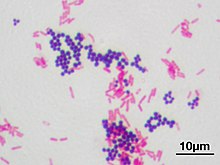Gram staining
Gram staining (or Gram's method) is a way of classifying bacteria into two large groups: gram-positive and gram-negative. The name comes from its inventor, Hans Christian Gram.

Gram's method stains bacteria according to the chemical and physical properties of their cell walls. First, a violet dye is put on the bacteria. This dye stains peptidoglycan, a thick layer that is only found in gram-positive bacteria.[1] After the first stain, another stain (usually safranin or fuchsin) gives all gram-negative bacteria a red or pink colour.
The Gram stain is almost always the first step in the identification of a bacterial organism. However, not all bacteria can be classified by this technique. Bacteria for which the method does not work are called 'gram-variable' or 'gram-indeterminate'.
Gram developed the technique working with another scientist, Carl Friedländer in a hospital in Berlin. However, Gram first used the test to make bacteria in the lungs easier to see.[2] He published his finished method in 1884.[3]
References
change- ↑ Bergey, David H.; et al. (1994). Bergey's manual of determinative bacteriology (9th ed.). Lippincott Williams & Wilkins. ISBN 0-683-00603-7.
- ↑ Austrian, R. (1960). "The Gram stain and the etiology of lobar pneumonia, an historical note". Bacteriol. Rev. 24 (3): 261–265. doi:10.1128/br.24.3.261-265.1960. PMC 441053. PMID 13685217.
- ↑ Gram H.C. (1884). "Über die isolierte Färbung der Schizomyceten in Schnitt- und Trockenpräparaten". Fortschritte der Medizin (in German). 2: 185–189..
English translation in: Brock T.D. (1999). Milestones in Microbiology 1546–1940 (2 ed.). ASM Press. pp. 215–218. ISBN 1-55581-142-6..
Translation is also at: Brock T.D. "Pioneers in medical laboratory science: Christian Gram 1884". Hoslink. Archived from the original on 2010-07-30. Retrieved 2010-07-27.{{cite journal}}: Cite journal requires|journal=(help)